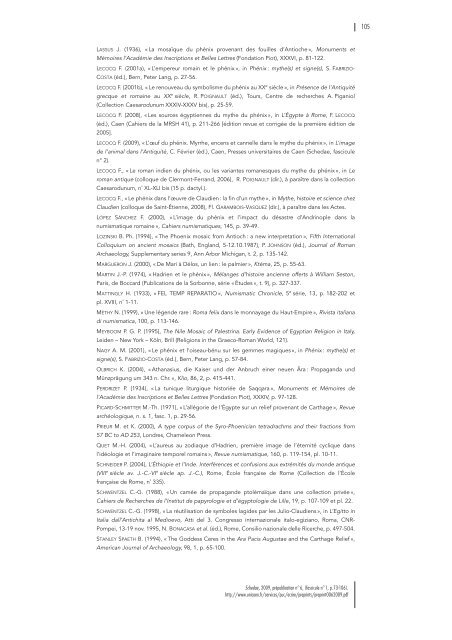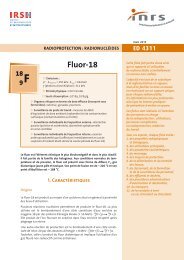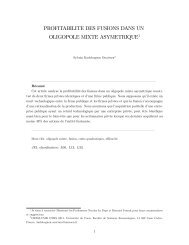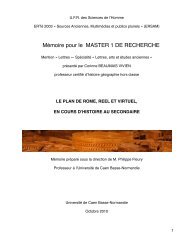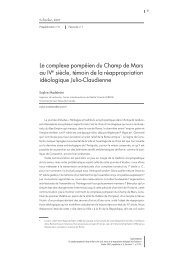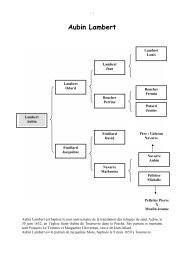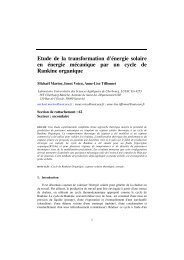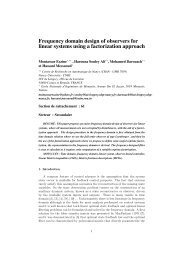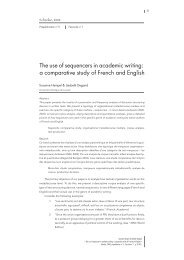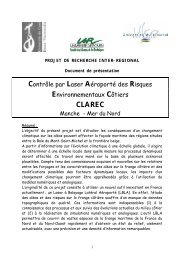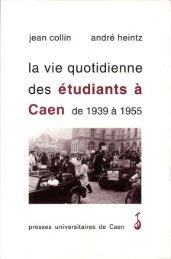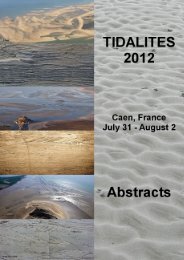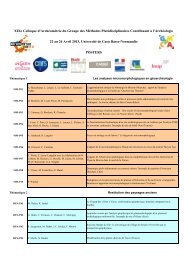1 - Université de Caen Basse Normandie
1 - Université de Caen Basse Normandie
1 - Université de Caen Basse Normandie
Create successful ePaper yourself
Turn your PDF publications into a flip-book with our unique Google optimized e-Paper software.
LASSUS J. (1936), « La mosaïque du phénix provenant <strong>de</strong>s fouilles d’Antioche », Monuments et<br />
Mémoires l’Académie <strong>de</strong>s Inscriptions et Belles Lettres (Fondation Piot), XXXVI, p. 81-122.<br />
LECOCQ F. (2001a), « L’empereur romain et le phénix », in Phénix : mythe(s) et signe(s), S. FABRIZIO-<br />
COSTA (éd.), Bern, Peter Lang, p. 27-56.<br />
LECOCQ F. (2001b), « Le renouveau du symbolisme du phénix au XXe siècle », in Présence <strong>de</strong> l’Antiquité<br />
grecque et romaine au XXe siècle, R. POIGNAULT (éd.), Tours, Centre <strong>de</strong> recherches A. Piganiol<br />
(Collection Caesarodunum XXXIV-XXXV bis), p. 25-59.<br />
LECOCQ F. (2008), « Les sources égyptiennes du mythe du phénix », in L’Égypte à Rome, F. LECOCQ<br />
(éd.), <strong>Caen</strong> (Cahiers <strong>de</strong> la MRSH 41), p. 211-266 [édition revue et corrigée <strong>de</strong> la première édition <strong>de</strong><br />
2005].<br />
LECOCQ F. (2009), « L’œuf du phénix. Myrrhe, encens et cannelle dans le mythe du phénix », in L’image<br />
<strong>de</strong> l’animal dans l’Antiquité, C. Février (éd.), <strong>Caen</strong>, Presses universitaires <strong>de</strong> <strong>Caen</strong> (Schedae, fascicule<br />
n° 2).<br />
LECOCQ F., « Le roman indien du phénix, ou les variantes romanesques du mythe du phénix », in Le<br />
roman antique (colloque <strong>de</strong> Clermont-Ferrand, 2006), R. POIGNAULT (dir.), à paraître dans la collection<br />
Caesarodunum, n˚ XL-XLI bis (15 p. dactyl.).<br />
LECOCQ F., « Le phénix dans l’œuvre <strong>de</strong> Claudien : la fin d’un mythe », in Mythe, histoire et science chez<br />
Claudien (colloque <strong>de</strong> Saint-Étienne, 2008), Fl. GARAMBOIS-VASQUEZ (dir.), à paraître dans les Actes.<br />
LÓPEZ SÁNCHEZ F. (2000), « L’image du phénix et l’impact du désastre d’Andrinople dans la<br />
numismatique romaine », Cahiers numismatiques, 145, p. 39-49.<br />
LOZINSKI B. Ph. (1994), « The Phoenix mosaic from Antioch : a new interpretation », Fifth International<br />
Colloquium on ancient mosaics (Bath, England, 5-12.10.1987), P. JOHNSON (éd.), Journal of Roman<br />
Archaeology, Supplementary series 9, Ann Arbor Michigan, t. 2, p. 135-142.<br />
MARGUERON J. (2000), « De Mari à Délos, un lien : le palmier », Ktèma, 25, p. 55-63.<br />
MARTIN J.-P. (1974), « Hadrien et le phénix », Mélanges d’histoire ancienne offerts à William Seston,<br />
Paris, <strong>de</strong> Boccard (Publications <strong>de</strong> la Sorbonne, série « Étu<strong>de</strong>s », t. 9), p. 327-337.<br />
MATTINGLY H. (1933), « FEL TEMP REPARATIO », Numismatic Chronicle, 5e série, 13, p. 182-202 et<br />
pl. XVIII, n˚ 1-11.<br />
MÉTHY N. (1999), « Une légen<strong>de</strong> rare : Roma felix dans le monnayage du Haut-Empire », Rivista italiana<br />
di numismatica, 100, p. 113-146.<br />
MEYBOOM P. G. P. (1995), The Nile Mosaic of Palestrina. Early Evi<strong>de</strong>nce of Egyptian Religion in Italy,<br />
Lei<strong>de</strong>n – New York – Köln, Brill (Religions in the Graeco-Roman World, 121).<br />
NAGY A. M. (2001), « Le phénix et l‘oiseau-bénu sur les gemmes magiques », in Phénix : mythe(s) et<br />
signe(s), S. FABRIZIO-COSTA (éd.), Bern, Peter Lang, p. 57-84.<br />
OLBRICH K. (2004), « Athanasius, die Kaiser und <strong>de</strong>r Anbruch einer neuen Ära : Propaganda und<br />
Münzprägung um 343 n. Chr. », Klio, 86, 2, p. 415-441.<br />
PERDRIZET P. (1934), « La tunique liturgique historiée <strong>de</strong> Saqqara », Monuments et Mémoires <strong>de</strong><br />
l’Académie <strong>de</strong>s Inscriptions et Belles Lettres (Fondation Piot), XXXIV, p. 97-128.<br />
PICARD-SCHMITTER M.-Th. (1971), « L’allégorie <strong>de</strong> l’Égypte sur un relief provenant <strong>de</strong> Carthage », Revue<br />
archéologique, n. s. 1, fasc. 1, p. 29-56.<br />
PRIEUR M. et K. (2000), A type corpus of the Syro-Phoenician tetradrachms and their fractions from<br />
57 BC to AD 253, Londres, Chameleon Press.<br />
QUET M.-H. (2004), « L’aureus au zodiaque d’Hadrien, première image <strong>de</strong> l’éternité cyclique dans<br />
l’idéologie et l’imaginaire temporel romains », Revue numismatique, 160, p. 119-154, pl. 10-11.<br />
SCHNEIDER P. (2004), L’Éthiopie et l’In<strong>de</strong>. Interférences et confusions aux extrémités du mon<strong>de</strong> antique<br />
(VIIIe siècle av. J.-C.-VIe siècle ap. J.-C.), Rome, École française <strong>de</strong> Rome (Collection <strong>de</strong> l’École<br />
française <strong>de</strong> Rome, n˚ 335).<br />
SCHWENTZEL C.-G. (1988), « Un camée <strong>de</strong> propagan<strong>de</strong> ptolémaïque dans une collection privée »,<br />
Cahiers <strong>de</strong> Recherches <strong>de</strong> l’Institut <strong>de</strong> papyrologie et d’égyptologie <strong>de</strong> Lille, 19, p. 107-109 et pl. 22.<br />
SCHWENTZEL C.-G. (1998), « La réutilisation <strong>de</strong> symboles lagi<strong>de</strong>s par les Julio-Claudiens », in L’Egitto in<br />
Italia dall’Antichita al Medioevo, Atti <strong>de</strong>l 3. Congresso internazionale italo-egiziano, Roma, CNR-<br />
Pompei, 13-19 nov. 1995, N. BONACASA et al. (éd.), Rome, Consilio nazionale <strong>de</strong>lle Ricerche, p. 497-504.<br />
STANLEY SPAETH B. (1994), « The God<strong>de</strong>ss Ceres in the Ara Pacis Augustae and the Carthage Relief »,<br />
American Journal of Archaeology, 98, 1, p. 65-100.<br />
Schedae, 2009, prépublication n°6, (fascicule n°1, p.73-106).<br />
http://www.unicaen.fr/services/puc/ecrire/preprints/preprint0062009.pdf<br />
105


